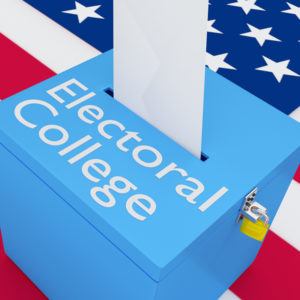With last year’s presidential election prompting legislative efforts to change state voting laws and the federal Electoral Count Act of 1887, the Electoral College is, once again, an issue of contention.
This “blot on democracy,” as it has been called, was created by the Founders to keep smaller states from being disenfranchised by larger states in deciding the presidential election. If a strict popular vote is the true determining factor that disenfranchises many states, the counterargument is the electoral system is patently unfair because electoral votes effectively vacate the popular vote.
What is needed is a methodology to blend the substance of each argument. This study is an effort to attain an acceptable parity. I call it the “County-Based System.”
This system aims to adjust the system to make it more effectuated by the popular vote but still to maintain the enfranchisement of the lesser states as it was designed. I believe the weighting and determination of the number of electoral votes is not so much the issue. The point of this study is to apply the theoretical justification to keep the system, but restructure it to make it more voter inclusive.
The electoral votes given to each state are locked for it, which means that, as an example, New York would have its normal 29 votes at stake available for candidates. That would not change. In a county-based system, there would be an allocation of those state’s electoral votes apportioned by the population of each county, then to the relative weight given by each county’s apportioned electoral votes to the actual votes cast.
A county’s electoral votes are essentially derived from a “vote weight,” which is first determined by proportioned ballots cast in that county against the total votes cast in the state. That county would be awarded proportionate to each candidate in that county. The sum total of the proportioned electoral votes would then be the total of the state’s votes that are logged by each candidate. In this way, the state’s electoral votes are split by county.
That is much more representative of the popular vote but preserves the electoral system. The methodology enables the counties to have a representative share and a say in the election. The alternative, as it now stands, is a winner-take-all scenario in which the popular vote determines the whole of the electoral votes for a given state with no quantified representation from counties that oppose the statewide vote. The disparity of votes between counties is then lessened.
One way to convert the Electoral College from a winner-take-all state system to a full county system would be to overlay the proportionality of the popular vote by county, to award the county its share of the electoral votes assigned to the winner of the county tally.
Under this county-based system, Biden’s Electoral College victory of 306 to 232 (based on his popular vote margin of 51.3 percent to Trump’s 46.9) would be a narrower 274 to 255 result, with nine votes going to other candidates — a more representative reflection of the voters’ choice.
Whatever lawmakers decide to do, the current system is ripe for reform. There is no better way to vest power in the people as the Founders envisioned than by empowering the counties.

